
Hiking Dude Blog
2025 - Aug Jul
2024 2023 2022 2021 2020 2019 2018 2017 2016 2015 2014 2013 2012 2011
07/25/2019
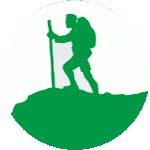
I finished hiking for today. You can check out my current location on the map and I'll post about my day when I am in coverage.
Posted: 07/25/2019
07/24/2019

I finished hiking for today. You can check out my current location on the map and I'll post about my day when I am in coverage.
Posted: 07/24/2019
07/22/2019

I finished hiking for today. You can check out my current location on the map and I'll post about my day when I am in coverage.
Posted: 07/22/2019
07/21/2019

I finished hiking for today. You can check out my current location on the map and I'll post about my day when I am in coverage.
Posted: 07/21/2019
07/19/2019
Posted: 07/19/2019
04/29/2019
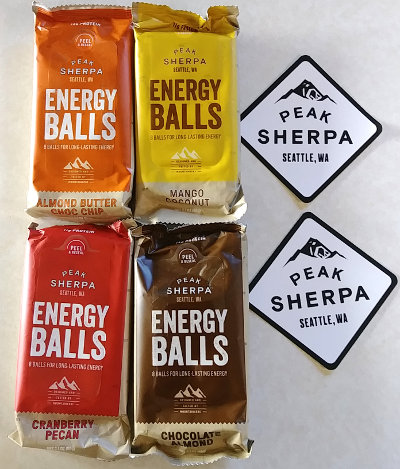
Energy Balls are bite size trail snacks packaged in resealable bags. They aren't your typical granola bar, or power bar, or whatever bar. They contain a nice mix of protein, fats, and carbs with some electrolytes thrown in. These are great for keeping a little energy in the tank throughout the day!
Specs: There are four flavors - Chocolate Almond, Almond Butter Chocolate Chip, Mango Coconut, and Cranberry Pecan. Each package contains 8 balls with about 260 calories total, and weighing 60 grams. The main ingredients are brown rice syrup, tapioca syrup, egg whites, and tsampa (Tsampa is a barley flour). The package is resealable. Costs about $3.
Review
Peak Sherpa sent me a sample pack of their four flavors to try out. I took them out on my morning hikes this past week, walking 26 miles over 3 days. I woke up, drank some water, and then took water and Energy Balls with me on my hike. I wanted to see how well the snacks would keep me going.
All four flavors tasted pretty darn good, but the Chocolate Almond seems a bit bland and just chocolatey. My favorite is the Mango Coconut because of taste and texture. The fruit and coconut tastes combined well with the almond butter base. Running a close second is Cranberry Pecan which had a maple taste to me even though there's no maple in it - I guess the pecans caused that. Anyway, the snacks tasted very good.
Having individual bite-sized balls makes it easy to just take a piece or share with a friend. A single bar with stamped creases might take up a bit less space and still be easy to divide.
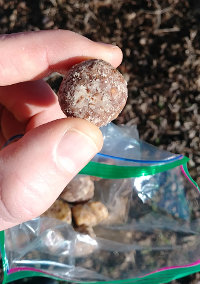

The packaging is fine, but the resealable feature just means a bit more plastic is used to make it more convenient. After my first day of hiking, I just dumped all the Energy Balls into a resealable zip-loc bag to reduce weight and stop the crinkly package noise, and still have the snacks sealed. Over three days, the balls didn't glump together and it was fun reaching in without looking to get a random flavor.
I ate a 35 calorie ball followed by a drink of water about every mile or so the first day. This was about 1/4 of the calories I was expending to hike, but it kept something in my stomach. I didn't feel any hunger for the 2.5 hours I hiked 10 miles.
On the next two days, I just popped a snack whenever I wanted. I wound up eating fewer but still didn't have any hunger.
Value:
On a pure calorie per dollar basis, at $3 for 260 calories, they are over $1.00/100cal (peanut butter is about $.08/100cal). But, at 120cal/ounce, they are pretty good for energy versus weight. The mix of nutrients makes them a great supplemental snack to add variety on a multi-day trek.


Wrap-Up:
I can recommend Peak Sherpa Energy Balls as a supplemental hiking snack, providing great taste and energy to keep you strong while hiking. They give you small boosts throughout the day to keep your motor powered and your body moving down the trail.
By integrating more protein and less sugar, using organic ingredients, and mixing interesting tastes, Peak Sherpa has created a very good trail snack. Besides that, Peak Sherpa donates 2% of their annual revenue to nonprofits like The Juniper Fund and The American Himalayan Foundation.
Hike On
Posted: 04/29/2019
03/06/2019


Now that our Kilimanjaro Trek is finished, I have some thoughts, suggestions, advice, or tips that might help someone else when planning to climb the mountain.
Things We Did Right
- Practice Hikes - we hiked 5 to 7 miles nearly every morning, in the cold snow and ice, for about two months before our trek. We hiked up the steepest hill in our area a few times each week for the month before our trek. I think the hills were the most valuable exercise!
- Clothing - we packed just enough for length of time and potential temperatures. We used pretty much all our clothes, but didn't fear the summit night hike.
- Daily Hydration - I made a point to drink a lot of water in camp each morning, and then some during the hiking. I drank very little in the evening so I didn't have to go during the night very often.
The arid, dusty, and windy air on the mountain sucks quite a bit of moisture out of you, even with no sweating and mild exertion. - Visit with Others - my wife and I made efforts to hike in different spots in our group so we could chat with different people. It kept the hikes fresh by learning a bit about 20 other people.
- Don't Worry - Americans tend to worry a lot about everything. Every evening, our lead guide gave us a brief idea of what the next day would bring, and then opened it up for questions. Our group tended to ask about everything from weather to trail conditions to food; sometimes things that either had obvious answers or no answers or didn't really matter. We had everything we needed in our day packs, so I just waited to see what each day brought.
Things We Did Wrong
- Didn't take enough pictures. Never enough pictures. A better camera would be nice, too, but they're such a burden to carry.
- Should have put more effort into learning some Swahili before the trek. Being ignorant and unable to communicate feels terrible.
- Should have spent more time on the summit. I'll never be there again and another 15 minutes would have made a more lasting impression.
Other Things
- The Food - I've put a bunch of pics of our food below. It was hot, healthy, tasty, and plentiful! We ate a lot and I was never hungry, but I still lost a few pounds. There was a plethora of fruits and vegetables, with meat and starch every day. No freeze-dried backpacking food, either - all very fresh and just wonderful.
- Medicines - We got an armful of shots before the trek - hepatitis, flu, and tetanus; plus pills for typhoid. On the trek, we took altitude pills, and malaria pills after summitting to prepare for our lower elevation safari adventures. Just in case, we had ultra-strength and regular strength diarrhea pills, acetaminophen, and ibuprofen - I didn't use any of them. I did take a daily multivitamin each day.
- Physical Concerns - The trek went great with no leg pains or injuries. I, along with 6 others, had blurry eye problems on the summit day, but it went away. Breathing in dust every day made for a some dirty nostrils, and the dry air gave me a nosebleed once.
- Human Waste - In all my research and reading, the problem of human waste and toilets on Kili came up over and over. I was expecting to tip toe around poop piles all the way up the mountain. What we encountered was much different. Oh, there were human waste problems along the trail, with toilet paper flowers dotting the landscape, but it was much less than I imagined.
Every camp had outhouses with no seats - our group called them Squatty Potties. Some were in better shape than others, but they all smelled pretty bad inside. Our large group paid extra to have 3 portable toilets lugged along with the rest of our camp gear so we could sit in clean, private comfort.
These toilets were wonderful but did make more work for some porters. All our waste 'flushed' into a small holding tank which a porter would disengage, slosh around, and carry to a permanent squatty potty to dump, bring it back, and set up.
In a small effort to be less of a burden, I used the squatty potties to pee always, and used our toilets only when necessary. I'm used to squatting in the woods on my long hikes, anyway. - Trash - A bigger, and more easily solved, problem was trash along the trail. I'll never understand how a person can carry a 4 ounce candy bar for miles but can't keep carrying the .2 ounce wrapper after eating the bar. With our lethargic pace, I had plenty of time to pick up bits and build a collection in a pack pocket. At each camp, I dumped the trash in a common bag outside the Thunder Dome. It's an easy way to help a little.
Finally, here are a few miscellaneous suggestions to consider that might make your trek more enjoyable:
- Wake before the sun at least a couple times to see the amazing stars and watch the day unfold.
- Take something special for your summit photo. I took an Ultimate Disc to play catch with, but the intense wind ruined that idea. Instead, I had a stick that I had spent the week whittling in our camps (pic below).
- When hiking, put room between you and the person ahead of you if you aren't conversing, so you aren't walking nose to butt. It lets you look around more, and feel free to stop to gaze and take pictures.
- Talk to your guides, cooks, and porters to learn about their lives, hopes, and dreams. Some of our guides were studying computers, engineering, and medicine - their guiding income was helping to pay for that.
- Learn Swahili words, and practice them. Jambo, Pole Pole, Wazungu, ... there are some fun sounding words.
- If you're going to use gaiters, get some Dirty Girl gaiters instead of knee-high snow gaiters - they are very light and keep the debris out of your shoes.
- Bring a cribbage board, or at least cards, for afternoon entertainment.
- Take photos of any glaciers you see since they'll not be there much longer.
- Lots of hours of hiking means lots of opportunity for jokes, riddles, and stories. Having a couple ready each day might make the hike more interesting for others in your group. I told this one and at least got a courtesy chuckle.
When you start planning your trip to Kilimanjaro or Tanzania, contact Tanzania Choice Safaris and see what they offer. They did a super job for our large group.









03/05/2019
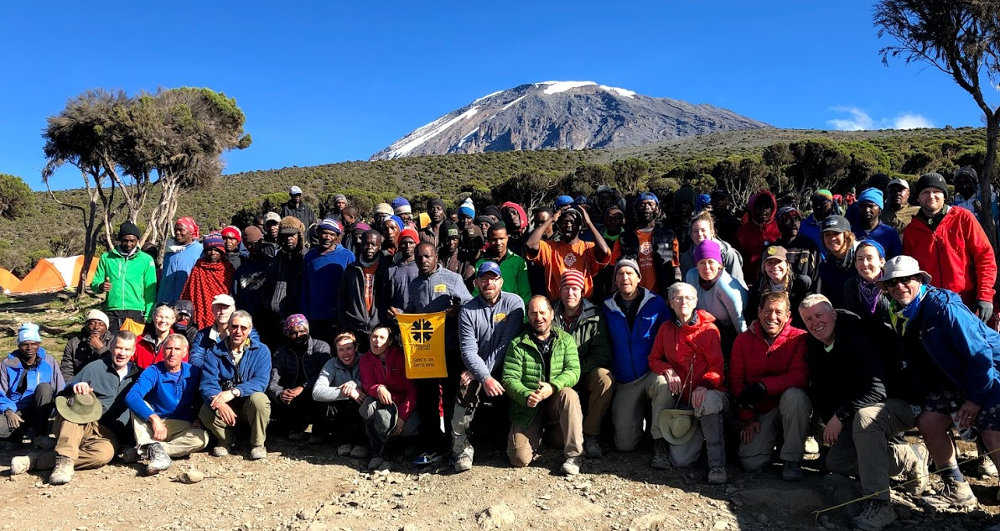

Our last meal on the mountain was a wonderful breakfast in the Thunder Dome. Yes, it had been recovered after being blown away last night. A few rips in the top, but still able to stand. After breakfast, we had the traditional Thank You ceremony with the support team. This is where the clients present monetary tips to the various support roles - porters, cooks, toilets, guides, and lead guide. It's customary to present the money and announce the amounts in front of all so there is no chance someone might pocket some that should be distributed. A couple fun songs and we were ready to scurry down the hill to a bus, lodge, and showers!
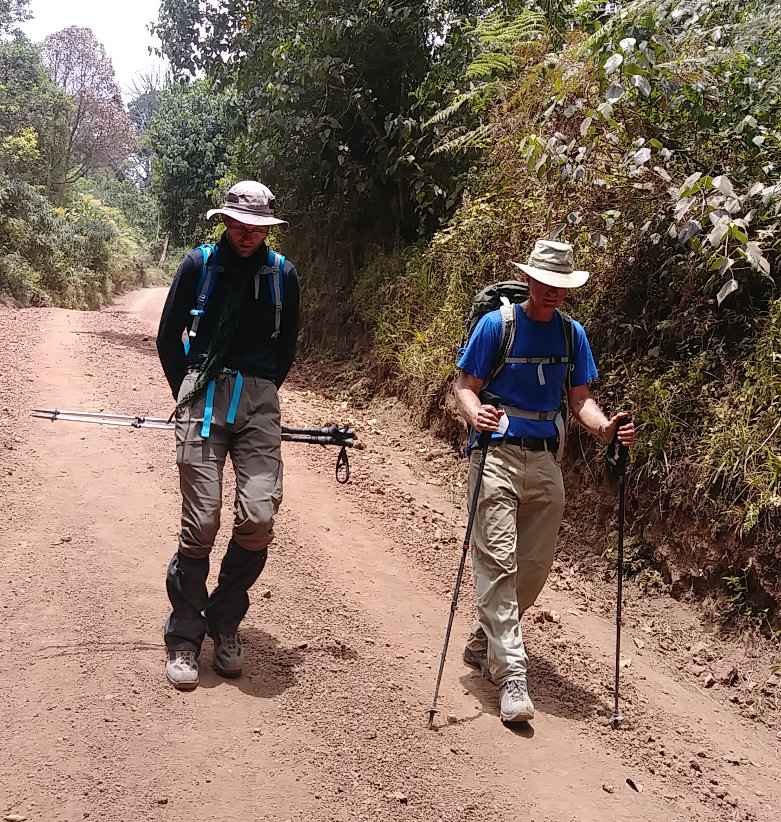

Surprisingly, today's long walk downhill caused more slips and injuries than the rest of the trek. The trail was fairly steep through a beautiful rain forest with lots of terraced steps that meant hard pounding of feet. That trail opened into a gravel road for another couple miles. The sand on this steep road was very slippery and I heard that most of us slipped at least a few times on the way down. I slid four times myself, with no injury but just more stress, and I saw one person not in our group actually fall ahead of me.
One highlight of this hike was that there were many monkeys causing a ruckus in the trees overhead a couple times. The other highlight was reaching the exit at Mweka Gate and having a cold beer while waiting for the rest of our gang. When we were all down, it started to rain as we loaded the buses, and there was even a few claps of thunder up the mountain. We drove to Meru Meru Lodge for showers, drinks, and a celebration dinner, followed by sleep in a luxurious bed.
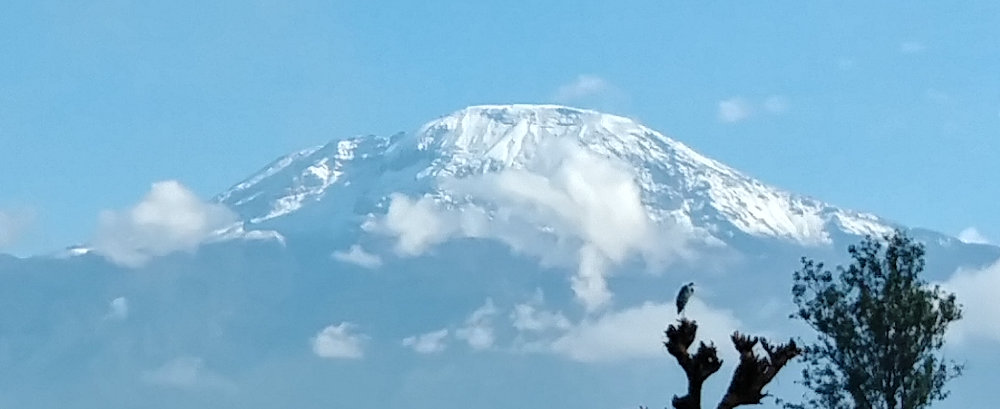

Even though the wind was a challenge on the mountain, we were very, very fortunate with weather on our trek. The wind destroyed some camps, and when we go off the mountain, it rained. Higher up, it snowed! This is the view of Kilimanjaro from our lodge the next morning when we woke to clear skies. Compare that to the photo of our mountain family above and you can see that our entire summit day would have been through fresh snow today.
We hiked from 12,500ft down to 5,400ft over a distance of about 7.5 miles.
Posted: 03/05/2019
03/04/2019
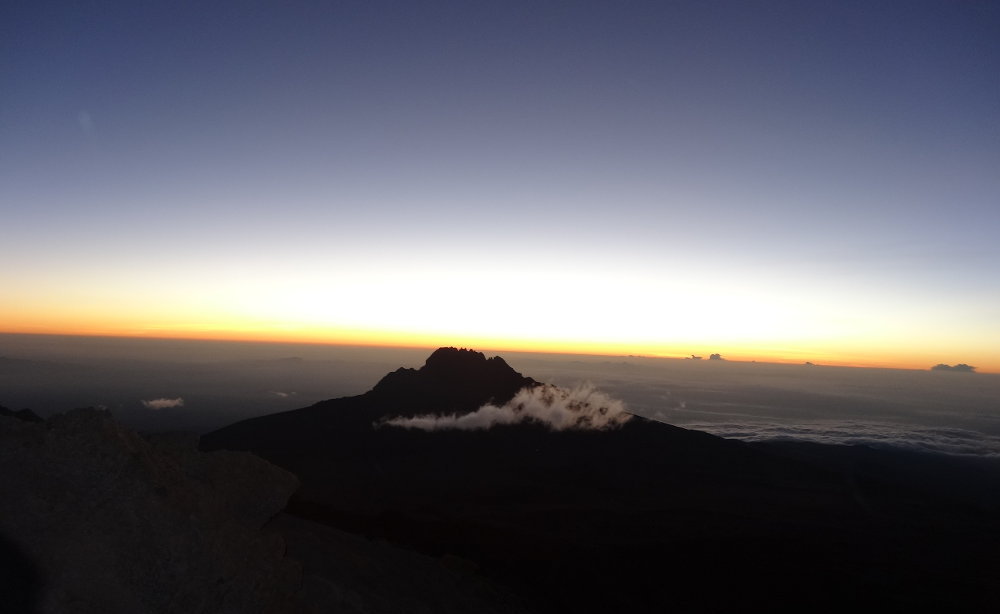

The excitement of 'Summit Day' came early for us. As we rested in the late afternoon at Barafu Camp, our cooks were hard at work. We enjoyed an early dinner in the Thunder Dome dining tent and then had the tough job of resting until our 2am planned departure for the summit.
The breeze that typically died off in the evening every day so far decided to take a different tact this day. As the sun sank lower, the wind picked up. And picked up. And picked up. The stakes holding the vestibule on our tent tore out of the ground, so I got out and piled rocks on them. They tore out again, so I got bigger rocks. Other tents were being buffeted as well. Inside the tent, all was fine and we could tune out the noise and fall asleep.
I'm not sure of the time, but I woke and it was dark night. Our tent was rattling and the vestibule was flapping yet again. I went out to fix it, and heard a commotion above the roar of the wind. Where our dining tent had been, there was just empty dirt. The entire tent had torn loose and blown somewhere out into the wild down the mountain! The kitchen tent was partially flattened and other tents were being rocked around, but held in place. Porters scrambled around to check stakes on some tents and pile more rocks on them. I had taken care of ours, so I headed back to bed.
Around 1am, I woke up and we got ready to go. I put on some layers and went out to see how I felt. I quickly went back in the tent and put on every layer I had - long undershirt, shirt, fleece, down jacket, and rain coat - long underwear, pants, rain pants - mittens, face mask, and stocking hat. I figured we would be doing a lot of standing around on the climb and that wind was doing a good job of pulling heat away. Eight hours after it started up, the windstorm was still building and it was difficult to even hear someone right next to you. Even with all this, the staff had hot drinks for us before we headed up the mountain - amazing!
There's not much to say or show about slowly hiking up a mountain in the dark. For the next 4 hours, we just trudged along following the person ahead of us. The sky was clear so we could see a trail of twinkling lights up the mountain as all the other climbers started earlier than we did. And, the stars were bright above. Eventually, the eastern sky lightened, we turned off our headlamps, and the sun finally rose. That didn't stop the wind, raise the temperature, or make the mountain less steep, but just being able to see around made the climb nicer.
About sunrise, I noticed that the vision in my right eye was blurring. The strong wind was blowing from the north, our right side, and I figured that must be causing problems. Dust and sand were flying and pinging off my face, but I didn't feel any irritation in my eye, just blurred vision. That's a bit scary when you don't know what's causing it. As it turns out, at least 7 people in our group experienced the same blurred vision - only in their right eye. A little research later indicated that blurred vision at high altitudes is a thing, somewhat common (After we descended later in the day, the vision problems went away).


The vision excitement was the only big deal I had happen on the climb. It was just a steady walk all the way up with little talking, a few short breaks, and plenty of dust. The temperature didn't seem all that cold, but it was enough to have frost on my faceshield, and ice slush in my water bottles. Quite a few people had their camelback hoses freeze up. Some people ran out of water (I shared mine).
Once it got light enough to see, I did notice there were some climbers coming down already - much too early to have made it to the summit. They were just 1s and 2s, and escorted by guides. I counted 11 separate groups, but I expect there were more I missed. They may have turned back due to the wind, exhaustion, or altitude illness, but they did not make the summit. None of them were from our group.
Around 8am, we finally finished the steep part of the climb and arrived at Stella Point. This is on the mountain rim, but not the absolute highest point. By this time, our large group had split into a few smaller groups going different speeds. We were in the first group and just kept on hiking after a short stop at the sign. The weather was pretty much the same except that clouds were now skittering across the landscape, hiding most of the summit view.
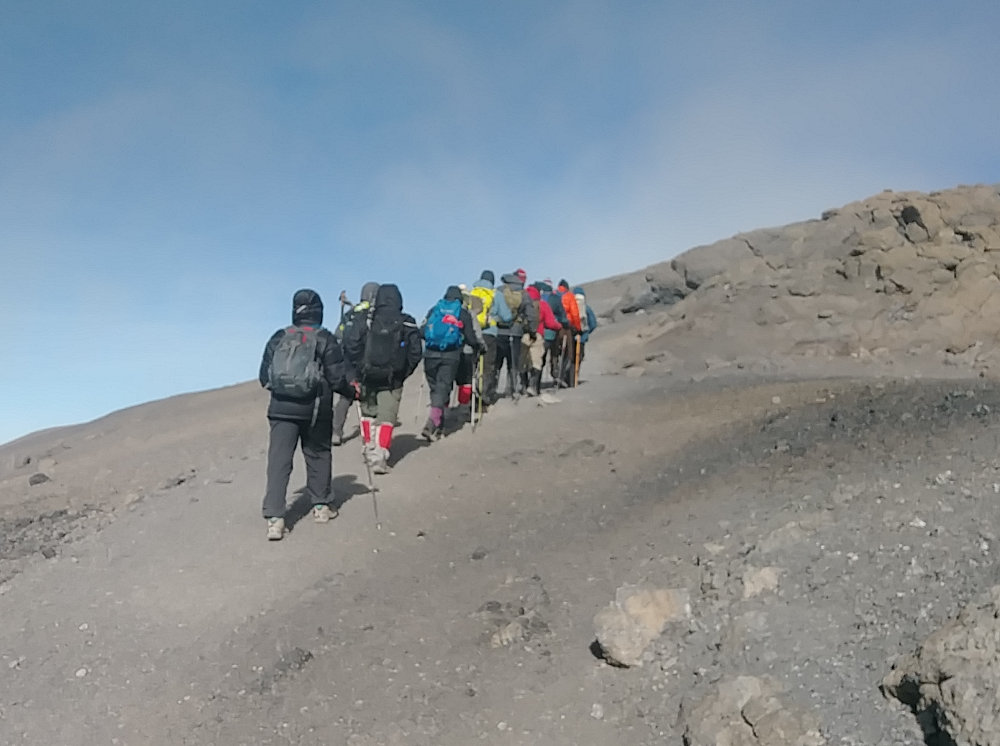

From here, the trail across the relatively flat mountain rim was soft and comfortable. The air was cold and thin, but everything was going just fine. Another 40 minutes or so of very easy hiking and we arrived at Uhuru Peak, the official summit. We made it! The clouds soared past, sometimes blanketing us in a whiteout and sometimes evaporating to show off the summit views.
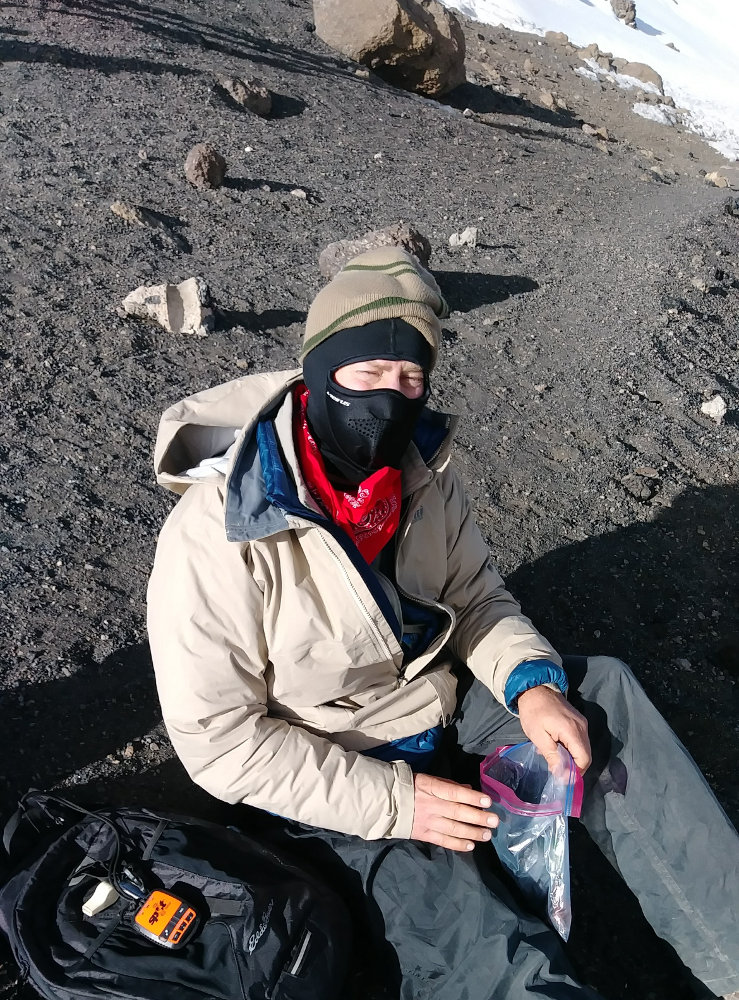

Here's me taking a snack break at the top just to show what I wore. The faceshield really worked great, warming the air a bit before breathing it in. I was never cold, nor sweating. By unzipping all the layers, I stayed just right the entire hike. The raincoat was a great windbreak and the down jacket insulated well. I carried my Spot Tracker on my day pack.
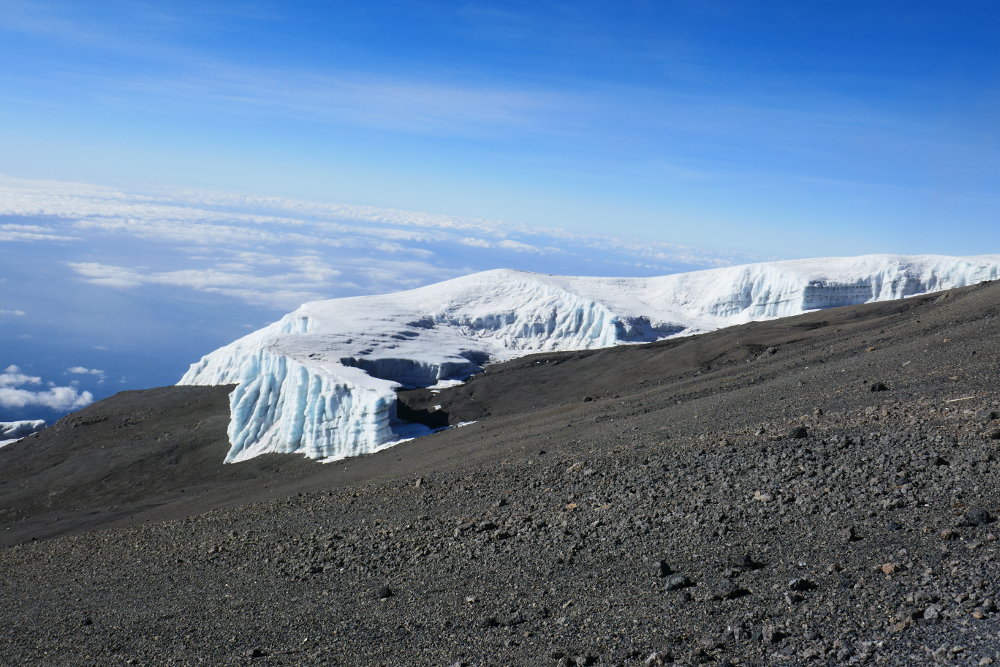

The Kilimanjaro glaciers are one of those brilliant natural wonders that are disappearing. Some say they will be gone in a few years, others say a few decades. There is only 18% of the ice that was there 100 years ago, so book your trip soon if you want to see them!


The majority of our group (16 I think) were at the sign at the same time. Another 5 were climbing slower and we were told to head down before they made it up. One person stopped at Stella Point. So, our entire group of 22 made it to the top of the mountain. I believe that is mostly because we took a long, slow route up the hill with a great support team that made sure we were doing well the entire trek.
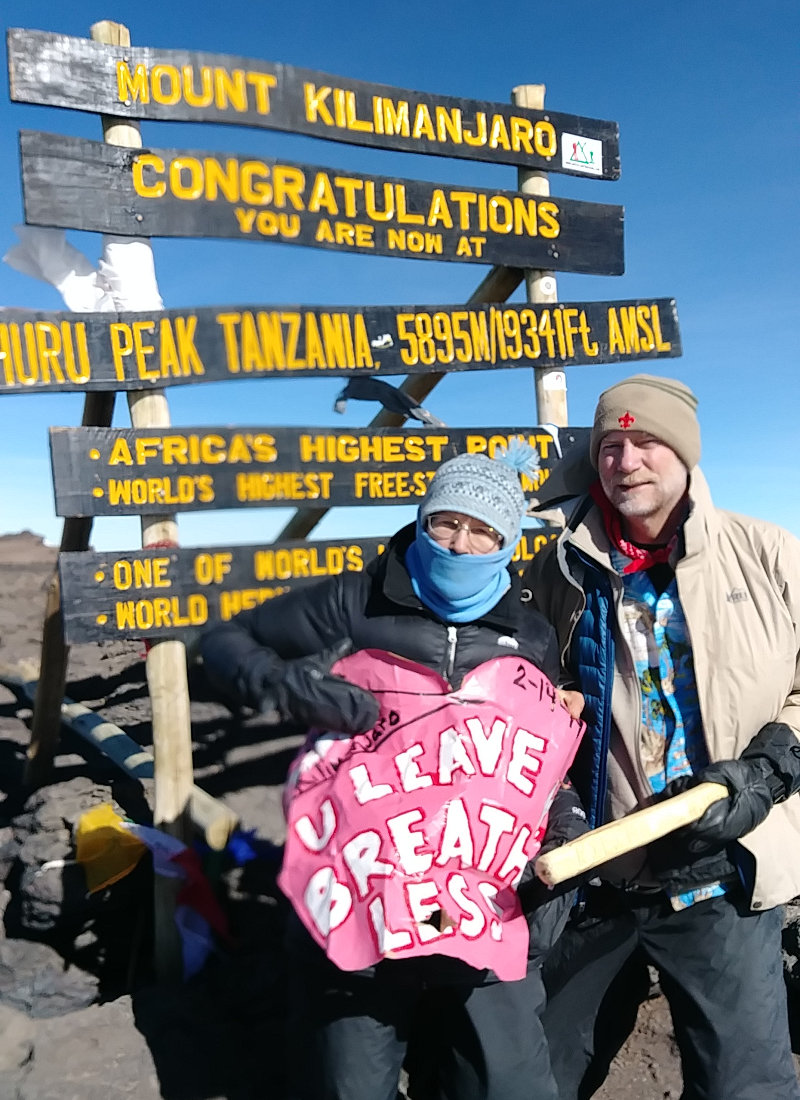

We summited on Valentine's Day, so my wife had a surprise card along that said 'You Leave Me Breathless'. The wind was STILL blowing so hard, it was a challenge to show it off.
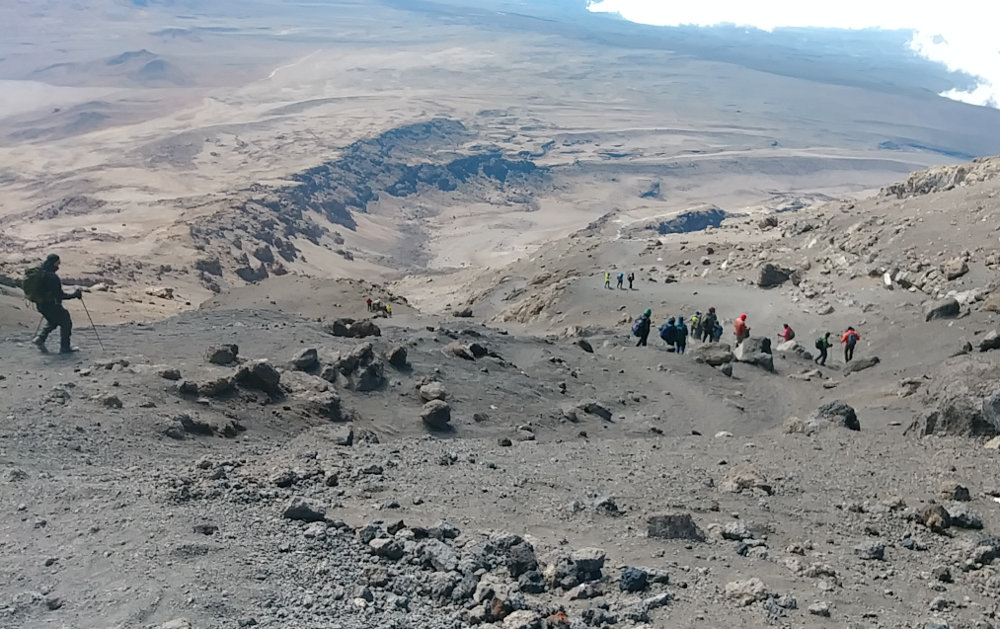

After only a very short time at the summit, we had to head back down. This was my one disappointment looking back on the trip - I would have liked to enjoy the summit longer.
The descent had caused me the most worry when planning for this hike. I was concerned how my knees would do pounding down a steep hillside for 6 or 7 miles. As it turned out, the soft scree and sand acted like a cushion for each step and my legs did just fine. It was a relatively fast hike down since gravity was helping so much and the trail was fine. We reached our camp at about noon, but could only stop for a short rest and to pack up our gear. This was because camp was moving down the mountain to make room here for the next wave of climbers coming up.
While we were gone for the past 10 hours, the wind had been blowing dust everywhere and there was a layer over everything inside our tent - because the vestibule had come loose yet again. Being the worst of our problems, that was really nothing. We packed up, gathered about 10 or 12 of us, and headed down, down, down being led by George our guide to Millennium Camp at 12,500 feet. It was an uneventful hike, but I really enjoyed dropping through all the environments as we got lower. Grasses, then bushes and brush, small trees, and finally forest covered the land as the elevation dropped.
Hopefully, this video will give you an idea of what the wind was like on the mountain. This is not our camp - it is one a bit higher up that we walked past on our way down. We found out later that some groups that were to summit the day after us had to abort their attempt because their tents and equipment got destroyed by the wind.
We hiked from 15,300ft up to 19,341ft and down to 12,500ft over a distance of about 9.25 miles.
Posted: 03/04/2019
03/03/2019


We are SOOOO Close! Looking up at the summit this morning felt like we really should be on our way up today! But, just one more short hike to get in position to push to the summit.
We've now been over 13,000 feet for 2.5 days and I've noticed no altitude issues at all. If I walk a short distance up the hillside at a normal pace, then I get winded, but no headache, sleeplessness, nausea, dizziness, or fatigue. I've checked my heart rate a couple times each day and it's normal. So, the Diamox we are taking is helping and/or we are treating our bodies well by slowly gaining altitude and taking it easy.
As usual, the clouds are all gone this morning and we have another beautiful, blue sky day ahead of us. I'll bet money that the clouds will build by 11am though.
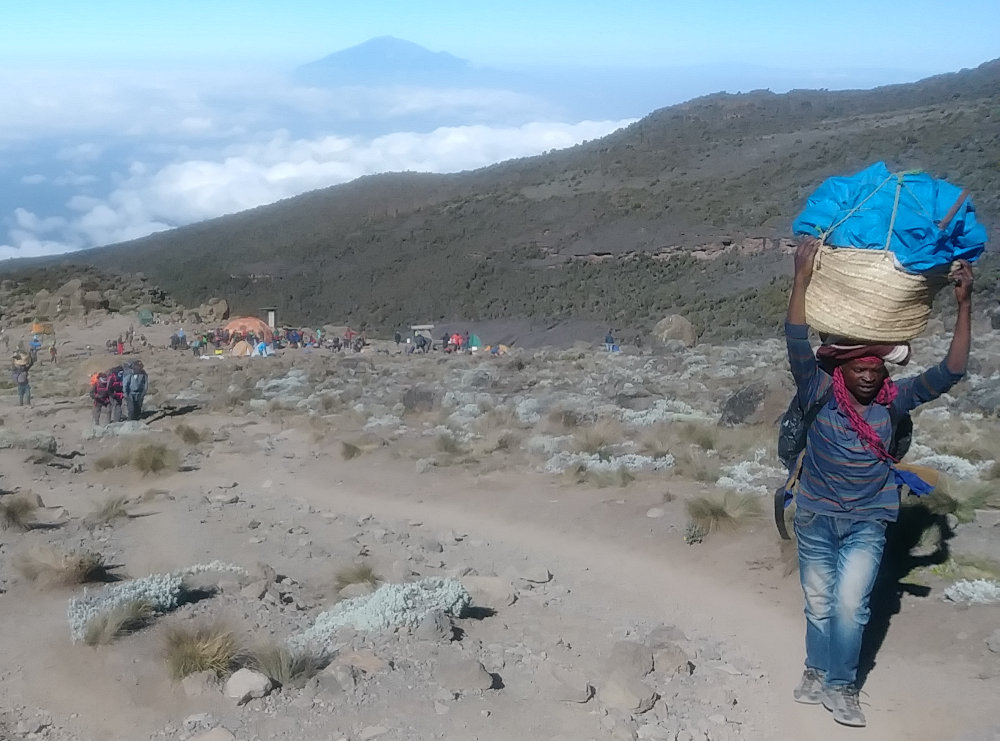

This will be the last day that our porters need to carry gear up the mountain. This young man is leaving Karanga Camp carrying his own 10 pounds of gear, plus 30 pounds of our stuff. The porters do amazing work on Kilimanjaro and watching them is the hardest part of the trek for me. Our outfitter seems to treat all the workers appropriately, holding to the rules in place and not abusing the porters. It's very hard work, but I've heard from many sources that it is the best work available in the region. Some of the key rules are:
- Porters get paid at least $8.50/day
- Porters carry no more than 15kg of gear plus 5kg of personal gear
- Porters get paid, plus tips, immediately at the end of the trek
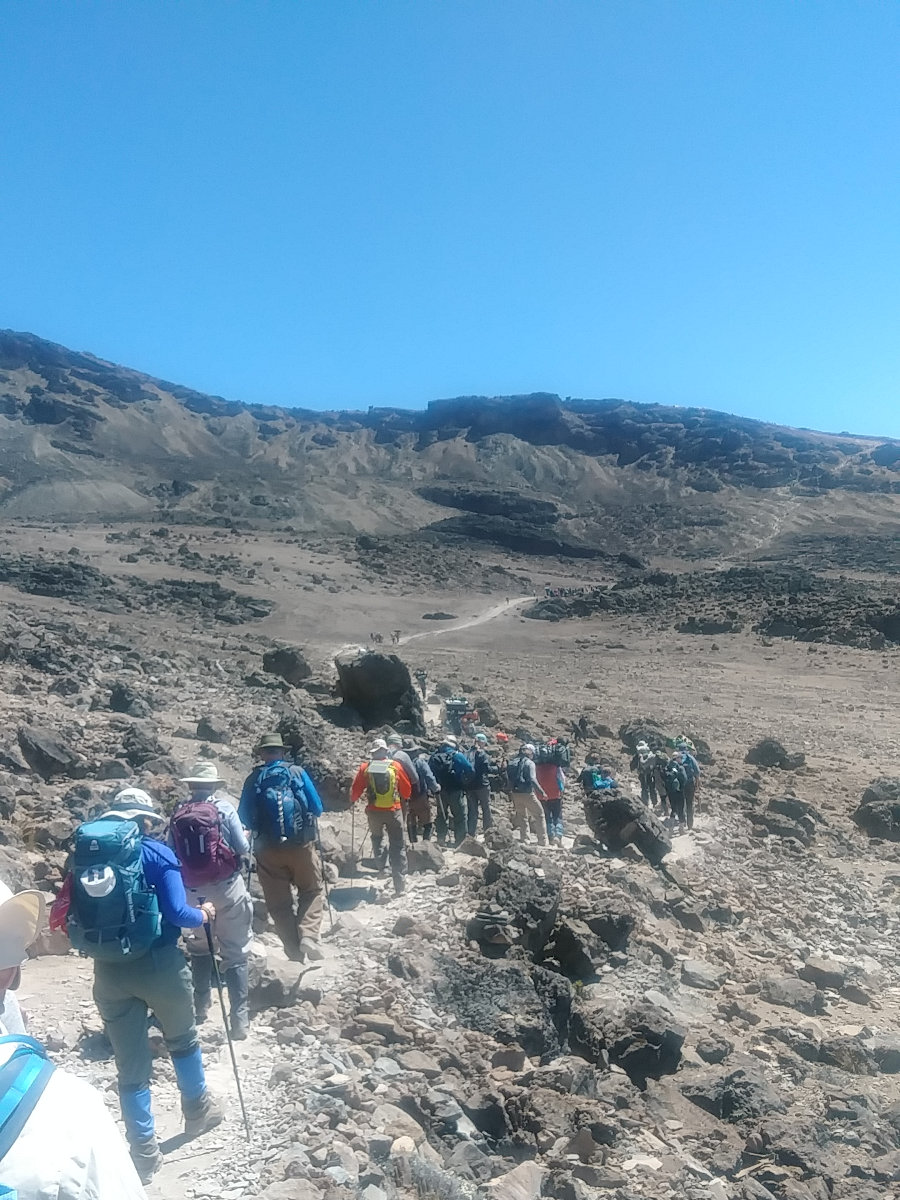

A couple hundred feet up the hillside from Karanga Camp, there was absolutely no vegetation left. From here on, rocks, gravel, sand, and dust are our friends! The sun is bright, the sky clear above us, and the trail a gradual climb along a well-worn path as we gain 2,200 feet - about 1000 feet per mile. This is a fairly steep grade, but we Pole Pole up and up, taking plenty of short rest breaks to enjoy the barren landscape and gaze over the accumulating clouds far below us. As long as they stay down there, we'll be just fine.
We have the mountain peak high above our left and the cloud covered plains far below our right all morning as we kick up dust. This photo shows our long, final ascent to Barafu Camp at 15,300 feet. We'll be camping up on that ridgeline where the trail seems to disappear.
From Karanga Camp to Barafu Camp, we crossed no streams or water source of any kind. That means all the water we use up at 15,300 foot high Barafu Camp, and on our summit hike, is carried all the way from the stream in the Karanga Valley which is about 3 miles and 2,500 feet in elevation away! A 5 gallon bucket of water weighs about 20kg. At this camp, we don't get bowls of hot water for washing - instead, we use a couple of wet wipes on our face and hands. All the water for drinking, cooking, and toilets is carried up.
Trying to make a tiny bit less work for others, I filled all my water bottles at Karanga and carried the water up myself so I would have it ready for the summit attempt in the morning. At least someone else didn't have to carry that small amount so far.
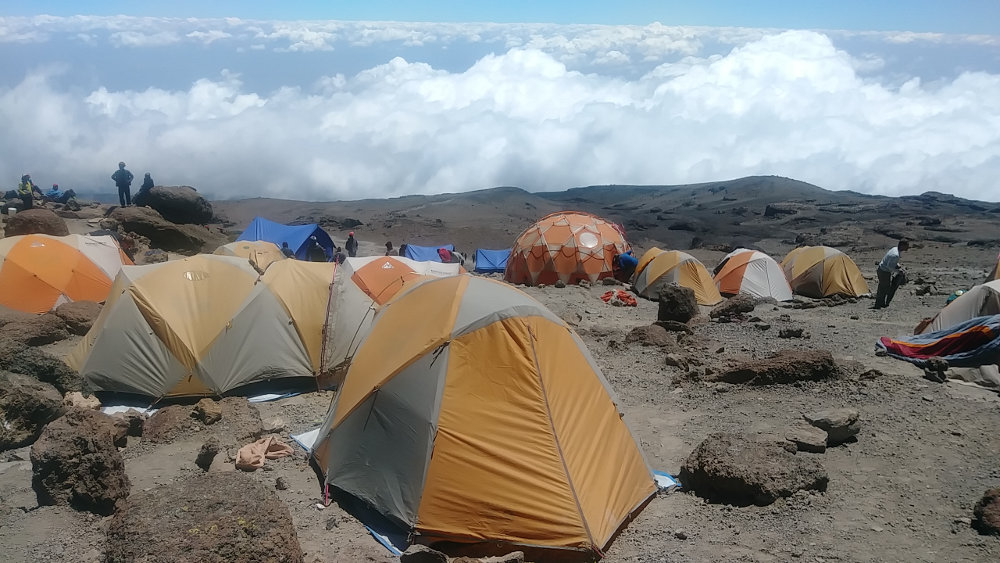

We reached our temporary home very early in the afternoon. The idea is that we'll clean up, eat, and then get what rest we can before we start our climb around 2am. It is pretty impressive how our crew can find flat tent spots on a rocky mountainside for all of us - well, for our tent at least. We've had wonderful spots at every camp. Here, you can see our tents packed between rocks with the cloud cover boiling below us. It's a beautiful, dry, breezy afternoon to rest and wait. Of course, over the other shoulder is the imposing summit silently waiting for our attempt to join the hundreds of thousands of others that have scampered to the top.
We hiked from 13,100ft up to 15,300ft over a distance of about 2.25 miles.
Posted: 03/03/2019
Older Posts Newer Posts
Find more Hiking Resources at www.HikingDude.com


Follow Me
Recent Comments